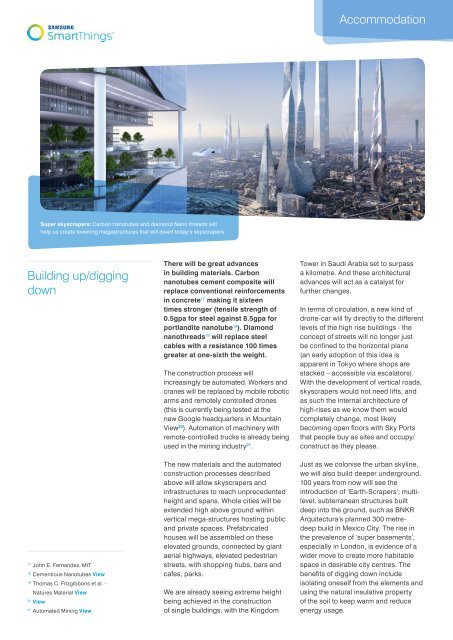Future Living Report
future-living-report
future-living-report
You also want an ePaper? Increase the reach of your titles
YUMPU automatically turns print PDFs into web optimized ePapers that Google loves.
Accommodation<br />
Super skyscrapers: Carbon nanotubes and diamond Nano threads will<br />
help us create towering megastructures that will dwarf today’s skyscrapers<br />
Building up/digging<br />
down<br />
17<br />
John E. Fernandez, MIT<br />
18<br />
Cementious Nanotubes View<br />
19<br />
Thomas C. Fitzgibbons et al. -<br />
Natures Material View<br />
20<br />
View<br />
21<br />
Automated Mining View<br />
There will be great advances<br />
in building materials. Carbon<br />
nanotubes cement composite will<br />
replace conventional reinforcements<br />
in concrete 17 making it sixteen<br />
times stronger (tensile strength of<br />
0.5gpa for steel against 8.5gpa for<br />
portlandite nanotube 18 ). Diamond<br />
nanothreads 19 will replace steel<br />
cables with a resistance 100 times<br />
greater at one-sixth the weight.<br />
The construction process will<br />
increasingly be automated. Workers and<br />
cranes will be replaced by mobile robotic<br />
arms and remotely controlled drones<br />
(this is currently being tested at the<br />
new Google headquarters in Mountain<br />
View 20 ). Automation of machinery with<br />
remote-controlled trucks is already being<br />
used in the mining industry 21 .<br />
The new materials and the automated<br />
construction processes described<br />
above will allow skyscrapers and<br />
infrastructures to reach unprecedented<br />
height and spans. Whole cities will be<br />
extended high above ground within<br />
vertical mega-structures hosting public<br />
and private spaces. Prefabricated<br />
houses will be assembled on these<br />
elevated grounds, connected by giant<br />
aerial highways, elevated pedestrian<br />
streets, with shopping hubs, bars and<br />
cafes, parks.<br />
We are already seeing extreme height<br />
being achieved in the construction<br />
of single buildings, with the Kingdom<br />
Tower in Saudi Arabia set to surpass<br />
a kilometre. And these architectural<br />
advances will act as a catalyst for<br />
further changes.<br />
In terms of circulation, a new kind of<br />
drone-car will fly directly to the different<br />
levels of the high rise buildings - the<br />
concept of streets will no longer just<br />
be confined to the horizontal plane<br />
(an early adoption of this idea is<br />
apparent in Tokyo where shops are<br />
stacked – accessible via escalators).<br />
With the development of vertical roads,<br />
skyscrapers would not need lifts, and<br />
as such the internal architecture of<br />
high-rises as we know them would<br />
completely change, most likely<br />
becoming open floors with Sky Ports<br />
that people buy as sites and occupy/<br />
construct as they please.<br />
Just as we colonise the urban skyline,<br />
we will also build deeper underground.<br />
100 years from now will see the<br />
introduction of ‘Earth-Scrapers’; multilevel,<br />
subterranean structures built<br />
deep into the ground, such as BNKR<br />
Arquitectura’s planned 300 metredeep<br />
build in Mexico City. The rise in<br />
the prevalence of ‘super basements’,<br />
especially in London, is evidence of a<br />
wider move to create more habitable<br />
space in desirable city centres. The<br />
benefits of digging down include<br />
isolating oneself from the elements and<br />
using the natural insulative property<br />
of the soil to keep warm and reduce<br />
energy usage.








